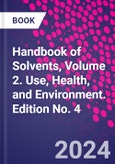This Fourth Edition of Handbook of Solvents, Volume 2, contains the most comprehensive information ever published on solvents as well as an extensive analysis of the principles of solvent selection and use. The book begins with a discussion of solvents used in over 30 industries which are the main consumers of solvents. The analysis is conducted based on the available data and contains information on the types (and frequently amounts) of solvents used and potential problems and solutions. Picking up where Handbook of Solvents, Volume 1 leaves off, Handbook of Solvents Volume 2 provides information on the methods of analysis of solvents and materials containing solvents, with 2 sections containing standard and special methods of solvent analysis, followed by a discussion of residual solvents left in the final products. The environmental impact of solvents, such as their fate and movement in the water, soil, and air, fate-based management of solvent-containing wastes, and ecotoxicological effects are discussed as are solvents' impact on tropospheric air pollution. The next 2 chapters are devoted to the toxicology of solvents and regulations aiming to keep solvent toxicity under control. The analysis of the concentration of solvents in more than 15 industries, specific issues related to the paint industry, and characteristics of the environment in automotive collision repair shops are followed by a thorough discussion of regulations in the USA and Europe. Following chapters show examples of solvent substitution by safer materials, with an emphasis on supercritical solvents, ionic liquids, deep eutectic solvents, and agriculture-based products, such as ethyl lactate. Discussion of solvent recycling, removal, and degradation includes absorptive solvent recovery, comparison of results of recovery and incineration, and application of solar photocatalytic oxidation. The book concludes with an evaluation of methods of natural attenuation of various solvents in soils and modern methods of cleaning contaminated soils.
Please Note: This is an On Demand product, delivery may take up to 11 working days after payment has been received.
Table of Contents
1. Solvent Use in Adhesives and Sealants2. Solvent Use in Aerospace
3. Solvent Use in Asphalt Compounding
4. Solvent Use in Biotechnology
5. Organic Solvents in Microbial Production Processes
6. Solvent Resistant Microorganisms
7. Choice of Solvent for Enzymatic Reaction in Organic Solvent
8. Solvent Use in Coil Coating
9. Solvent Use in Cosmetics and Personal Care Products
10. Solvent Use in Dry Cleaning- Treatment of Textiles in Solvents
11. Solvent Use in the Electronic Industry
12. Solvent Use in Fabricated Metal Products
13. Solvent Use in the Food Industry
14. Solvent Use in Ground Transportation
15. Solvent Use in Inorganic Chemical Industry
16. Solvent Use in Iron and Steel Industry
17. Solvent Use in Lumber and Wood Products
18. Solvent Use in Medical Applications
19. Solvent Use in Metal Casting
20. Solvent Use in Motor Vehicle Assembly
21. Solvent Use Organic Chemical Assembly
22. Solvent Use in Paints and Coatings
23. Architectural Surface Coatings and Solvents
24. Recent Advances in Coalescing Solvents for Waterborne Coatings
25. Solvent Use in the Petroleum Refining Industry
26. Solvent Use in the Pharmaceutical Industry
27. Use of Solvents in the Manufacture of Drug Substances and Drug Products
28. Predicting Cosolvency for Pharmaceutical and Environmental Applications
29. Solvent Use in Polymers and Man-Made Fibers
30. Solvent Use in the Printing Industry
31. Solvent Use in Pulp and Paper
32. Solvent Use in Rubber and Plastics
33. Solvent Use in the Shipbuilding and Ship Repair Industry
34. Solvent Use with Stone, Clay, Glass, and Concrete
35. Solvent Use in the Textile Industry
36. Solvent Use for Transportation Equipment Cleaning
37. Solvent Use in Water Transportation
38. Solvent Use with Wood Furniture
39. Standard Methods of Solvent Analysis
40. Special Methods of Solvent Analysis
41. Simple Test to Determine Toxicity of Bacteria
42. Residual Solvents in Various Products
43. Residual Solvents in Pharmaceutical Substances and Products
44. The Environmental Fate and Movement of Organic Solvents in Water, Soil, and Air
45. Fate-Based Management of Organic Solvent-Containing Wastes
46. Organic Solvent Impacts on Tropospheric Air Pollution
47. Measurement and Estimation of Solvents Emissions and Odor
48. Emission of Organic Solvents During Usage of Ecological Paints
49. Indoor Air Pollution by Solvents Contained in Paints and Varnishes
50. Solvent Uses with Exposure Risks
51. Solvent Regulations in the US and Other Countries
52. Solvent Regulations in Europe
53. Toxicokinetics, Toxicodynamics, and Toxicology
54. Pregnancy Outcome Following Maternal Organic Solvent Exposure
55. Industrial Solvents and Kidney Disease
57. Lymphohematopoietic Study of Workers Exposed to Benzene Including Multiple Myeloma, Lymphoma, and Chronic Lymphatic Leukemia
58. Solvent Use and Chromosomal Aberrations and Sister Chromatoid Exchanges
59. Solvent Use and Hepatoxicity60. Toxicity of Environmental Solvent Exposure for Brain, Lung, and Heart
60. Supercritical Solvents
61. Ionic Liquids
62. Deep Eutectic Solvents and Their Applications as New Green Reaction Media
63. Novel Applications of the Bio-Based Solvent Ethyl Lactate in Chemical Technology
64. Absorptive Solvent Recovery
65. Solvent Recovery
66. Solvent Treatment in a Paints and Coating Plant
67. Application of Solar Photocatalytic Oxidation to VOC-Containing Airstreams
68. Gloves for Solvent Use
69. Suit Materials for Solvent Use
70. Respiratory Protection for Solvent Use








